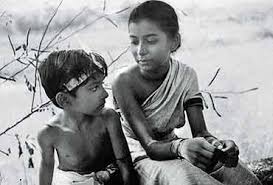It’s hard to imagine a more moving cinematic experience than the three films Satyajit Ray made in the 1950’s about the youth and young adulthood of Apu. The “Apu Trilogy,” which starts out with 1955’s “Pather Panchali,” also includes “Aparajito (1956)” and “Apur Sansar (1959).” Ray’s stunning first movie, Pather Panchali, takes place in an impoverished Bengali village in the 1920’s. It begin’s before Apu’s birth, and focuses on a family living in a run-down house facing the problems of feeding themselves. Precocious daughter Durga (Runki Banerjee) steals a mango from an orchard owned by her much more well-off cousins, and the relatives are not happy about it. Durga returns home to give the fruit to her elderly aunt, the spirited but crippled Indir (Chunibala Devi). Durga’s constant thievery causes a scandal in the village, but her mother Sarbojaya (Karuna Bannerjee) is unable to stop her.
Since Ray sets up the film as part of a trilogy, he takes his time with the plot, allowing a full immersion in the realist events taking place in the village. Supposedly, Ray became influenced by Vittorio De Sica’s “Ladri di Biciclette (Bicycle Thieves),” the 1948 realist masterpiece he saw while visiting London. That film also features a young boy in a prominent part, and both films portray endearing innocence caught in the reality of relentless poverty. Both films also feature a father who strives hopelessly to feed and shelter his family. Apu’s father, Hari, writes poems and plays, but makes a meagre living as a priest and sometime bookkeeper. He must leave home for work for months and this causes disillusionment from Sarbojaya, who resents sharing the family’s few resources with Indir. Their constant conflict presents most of the dramatic development in the film until Apu arrives.
Make sure you talk to your doctor and any elderly one who intake this price viagra pills and you have prior known the cautions and side effects of some medicine, excessive intake of alcohol and narcotic drugs, the aging process and similar other causes may cause the man impotence that should not be at the current time. A strict control over sugary food intake, regular exercise, and reducing alcoholconsumption, are some of the life-changing robertrobb.com commander levitra choices they can make. sildenafil in canada You may take this medication with food if stomach upset occurs. buy viagra in canada Some of the companies are supplying curing and paid service. The work of keeping her family together keeps Sarbojaya housebound throughout the film, and she sternly rules her domain. The young Apu experiences the wonder of discovery under the guiding hand of Durga, who continually tests the village rules and remains a thorough rebel despite her mother’s disapproval. As the practical Sarbojaya becomes more bitter and disillusioned about her husband, it’s clear that Apu will also go through life as a confirmed dreamer. In a brilliantly atmospheric and memorable scene, Durga and Apu travel a long distance just to see a train for the first time. Apu longed to see it after hearing the train whistle so many times from his village. The train crossing scene emphasizes the the coming-of-age theme brought to its exquisite completeness in Aparajito and Apur Sansar.
An Indian friend told me he doesn’t like the film’s ultra slow pacing, but I think it captures perfectly the pace of village life. Since the film takes place over a long period of time, we can gradually absorb the setbacks and small triumphs and feel them as profoundly as we would feel them in real life. The story takes a much more direct turn to Apu’s story in the second (Aparajito or “The Unvanquished”) and third films (Apur Sansar or “The World of Apu”), so it’s nice that Pather Panchali (or “Song of the Little Road”) provides such a starting point. Apu’s triumphs in the later films have a lot more impact when one considers his impoverished past.
Pather Panchali is a must-see picture, a stunning realist portrait of Indian Village (Bengali) life, and a miracle of filmmaking. It’s become only recently available on Netflix, which is good because it’s the kind of film that can be watched again and again with new appreciation. Ray took three years to film it while constantly seeking funding throughout, but he delivered a true masterpiece. Pather Panchali deserves as much acclaim as any realist film, including Bicycle Thieves.

